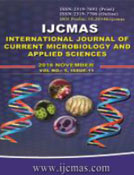


 National Academy of Agricultural Sciences (NAAS)
National Academy of Agricultural Sciences (NAAS)

|
PRINT ISSN : 2319-7692
Online ISSN : 2319-7706 Issues : 12 per year Publisher : Excellent Publishers Email : editorijcmas@gmail.com / submit@ijcmas.com Editor-in-chief: Dr.M.Prakash Index Copernicus ICV 2018: 95.39 NAAS RATING 2020: 5.38 |
Honeybee and plant have a special symbiotic relationship. Bee flora is important for establishing bee keeping industry. The awareness to maintain the existing bee flora and multiplication of plant species is important for its sustainability. Plant types and their flowering duration differ from one place to other due to variation in topography, climate and other cultural and farming practices. The knowledge of bee flora of medicinal plants enable beekeepers to utilize them at the maximum level, so that they can harvest a good yield and quality of honey with medicinal importance and other bee products in addition to effective pollination, which enhances crop yields. This region has its own honey flow and floral dearth periods of short and long duration. The knowledge on bee flora help in the effective management of bee colonies during such periods. Based on available flora, major characteristics of these plant species, pollen and nectar availability and flowering duration, a bee floral calendar as per the season was developed. To conserve these floras, attention must be given to maintain and multiply the existing flora. Considering these facts, the present study was carried out to prepare an inventory of existing medicinal bee flora and develop a floral calendar for that particular region. We analysed 50 species of medicinal plants were promising as potential bee foragers for honeybees. Some of the common and important medicinal bee forage plants are the species of Azadirachta indica, Mangifera indica, Cassia fistula, Cassia occidentalis, Albizzia spp., Bauhinia spp. and Prosopis juliflora etc. This information is useful for bee keepers and is helpful to improve quality of honey and sustaining medicinal biodiversity.
 |
 |
 |
 |
 |